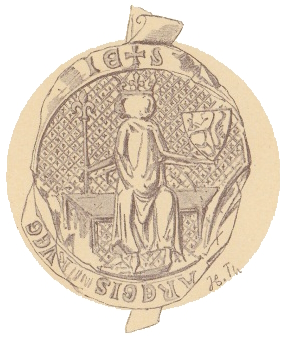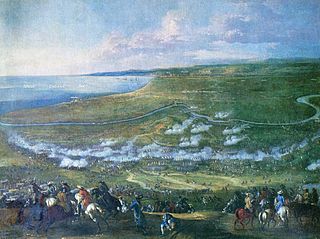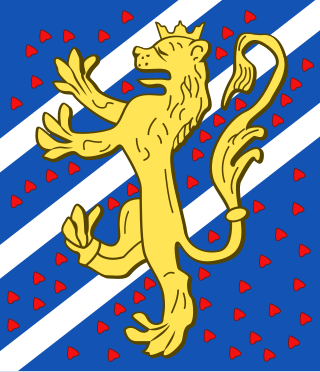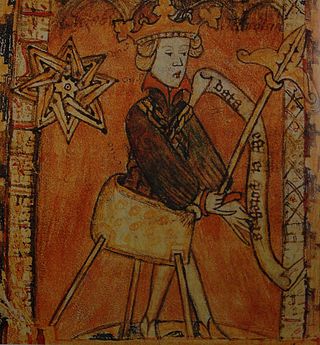
Magnus Ladulås or Magnus Birgersson was King of Sweden from 1275 until his death in 1290.

Halland is one of the traditional provinces of Sweden (landskap), on the western coast of Götaland, southern Sweden. It borders Västergötland, Småland, Scania and the sea of Kattegat. Until 1645 and the Second Treaty of Brömsebro, it was part of the Kingdom of Denmark. Its name means Land of Rocky Slabs referring to the coastal cliffs of especially the northern part of the region.

Valdemar I Knudsen, also known as Valdemar the Great, was King of Denmark from 1154 until his death in 1182. The reign of King Valdemar I saw the rise of Denmark, which reached its medieval zenith under his son King Valdemar II.

Haakon VI, also known as Håkan Magnusson, was King of Norway from 1343 until his death and King of Sweden between 1362 and 1364. He is sometimes known as Haakon Magnusson the Younger to distinguish him from his great-grandfather, Haakon V.

Valdemar IV Atterdag, Valdemar Christoffersen or Waldemar was King of Denmark from 1340 to 1375. He is mostly known for his reunion of Denmark after the bankruptcy and mortgaging of the country to finance wars under previous rulers.

Valdemar Birgersson, also Waldemar, was King of Sweden from 1250 to 1275.

Magnus the Lawmender, also known as Magnus Haakonsson, was King of Norway from 1263 to 1280. One of his greatest achievements was the modernisation and nationalisation of the Norwegian law-code. He was the first Norwegian monarch known to have used an ordinal number, counting himself as Magnus IV. In modern sources, he is also known as Magnus VI.

The Battle of Halmstad, also known as the Battle at Fyllebro, was fought on August 17, 1676, at Fyllebro, approximately 4 km (2.5 mi) southeast of the town of Halmstad in the province of Halland in southwest Sweden. It was the last battle in Halland between Denmark and Sweden.

Erik Magnusson was a Swedish duke and the second son of King Magnus Ladulås. His duchy consisted of large parts of Sweden, as well as smaller parts of Norway and Denmark. He had a troubled relationship with his brother, King Birger Magnusson, with several uprisings as a result. His son, Magnus, became the king of Norway and Sweden. The Erik's Chronicle, the oldest Swedish chronicle, is named for him.

The Håtuna games were a 1306 conflict between Birger, King of Sweden (1280–1321) and his two brothers, the dukes Eric Magnusson and Valdemar Magnusson.

Ingeborg of Norway was a Norwegian princess and by marriage a Swedish royal duchess with a position in the regency governments in Norway (1319–1327) and Sweden (1319–1326) during the minority of her son, King Magnus Eriksson. In 1318–1319, she was Sweden's de facto ruler, and from 1319 until 1326, she was Sweden's first de jure female regent. Her role in northern European history is considered of major importance.
The title of King of the Goths was for many centuries borne by both the kings of Sweden and the kings of Denmark.
Bengt Algotsson was a medieval Swedish lord. He was the Duke of Finland and Halland, as well as the Viceroy of Scania in 1350s.

Sophia of Denmark was Queen of Sweden as the consort of King Valdemar.

The Battle of Helsingborg was the last major engagement of the Great Northern War to take place on Swedish soil. It resulted in a decisive victory of a Swedish force of 14,000 men under the command of Magnus Stenbock against a Danish force of equal strength under the command of Jørgen Rantzau, ensuring that Denmark's final effort to regain the Scanian territories that it had lost to Sweden in 1658 failed. The battle was fought on 10 March 1710 in the province of Scania, just outside the city of Helsingborg, and directly on the Ringstorp heights just north-east of the city.

Helvig of Holstein was Queen of Sweden as the consort of King Magnus Ladulås. Her parents were Gerhard I, Count of Holstein-Itzehoe and Elisabeth of Mecklenburg.

The House of Estridsen was a dynasty that provided the kings of Denmark from 1047 to 1412. The dynasty is named after its ancestor Estrid Svendsdatter. The dynasty is sometimes called the Ulfinger, after Estrid's husband, Ulf Jarl. The dynasty also provided three medieval rulers of Sweden and one of Norway. Their family coat of arms became the coat of arms of Denmark and thereby influenced the coat of arms of Tallinn and the coat of arms of Estonia.
Events from the 13th century in Denmark.

The First Swedish–Norwegian union, was a personal union of the separate kingdoms of Sweden and Norway together with Norway's overseas colonies .The union was founded by King Magnus IV of Sweden in 1319 and dissolved in 1355, briefly re-uniting in 1362 until 1365.

The Kalundborg War was a conflict spanning three years between Sweden, Norway and Holstein, and an alliance consisting of Denmark, Lübeck, Hamburg, Rostock, Wismar, Greifswald, and Stralsund. Although Denmark achieved some victories, the war ended favourably for Sweden, Norway and Holstein.
















